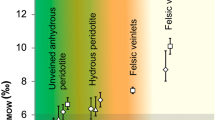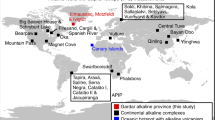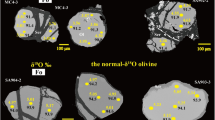Abstract
Basaltic lavas erupted at some oceanic intraplate hotspot volcanoes are thought to sample ancient subducted crustal materials1,2. However, the residence time of these subducted materials in the mantle is uncertain and model-dependent3, and compelling evidence for their return to the surface in regions of mantle upwelling beneath hotspots is lacking. Here we report anomalous sulphur isotope signatures indicating mass-independent fractionation (MIF) in olivine-hosted sulphides from 20-million-year-old ocean island basalts from Mangaia, Cook Islands (Polynesia), which have been suggested to sample recycled oceanic crust3,4. Terrestrial MIF sulphur isotope signatures (in which the amount of fractionation does not scale in proportion with the difference in the masses of the isotopes) were generated exclusively through atmospheric photochemical reactions until about 2.45 billion years ago5,6,7. Therefore, the discovery of MIF sulphur in these young plume lavas suggests that sulphur—probably derived from hydrothermally altered oceanic crust—was subducted into the mantle before 2.45 billion years ago and recycled into the mantle source of Mangaia lavas. These new data provide evidence for ancient materials, with negative Δ33S values, in the mantle source for Mangaia lavas. Our data also complement evidence for recycling of the sulphur content of ancient sedimentary materials to the subcontinental lithospheric mantle that has been identified in diamond-hosted sulphide inclusions8,9. This Archaean age for recycled oceanic crust also provides key constraints on the length of time that subducted crustal material can survive in the mantle, and on the timescales of mantle convection from subduction to upwelling beneath hotspots.
This is a preview of subscription content, access via your institution
Access options
Subscribe to this journal
Receive 51 print issues and online access
$199.00 per year
only $3.90 per issue
Buy this article
- Purchase on Springer Link
- Instant access to full article PDF
Prices may be subject to local taxes which are calculated during checkout



Similar content being viewed by others
References
Hofmann, A. W. & White, W. M. Mantle plumes from ancient oceanic crust. Earth Planet. Sci. Lett. 57, 421–436 (1982)
White, W. & Hofmann, A., Sr and Nd isotope geochemistry of oceanic basalts and mantle evolution. Nature 296, 821–825 (1982)
Hauri, E. & Hart, S. R. Re-Os isotope systematics of HIMU and EMII oceanic island basalts from the south Pacific Ocean. Earth Planet. Sci. Lett. 114, 353–371 (1993)
Hanyu, T. et al. Geochemical characteristics and origin of the HIMU reservoir: a possible mantle plume source in the lower mantle. Geochem. Geophys. Geosyst.. 12, Q0AC09, http://dx.doi.org/10.1029/2010GC003252 (2011)
Farquhar, J., Bao, H. & Thiemens, M. Atmospheric influence of Earth’s earliest sulfur cycle. Science 289, 756–758 (2000)
Farquhar, J., Zerkle, A. L. & Bekker, A. Geological constraints on the origin of oxygenic photosynthesis. Photosynth. Res. 107, 11–36 (2011)
Johnston, D. T. Multiple sulfur isotopes and the evolution of Earth’s surface sulfur cycle. Earth Sci. Rev. 106, 161–183 (2011)
Farquhar, J., Wing, B., McKeegan, K. & Harris, J. Mass-independent sulfur of inclusions in diamond and sulfur recycling on early Earth. Science 298, 2369–2372 (2002)
Thomassot, E. et al. Metasomatic diamond growth: a multi-isotope study (13C, 15N, 33S, 34S) of sulphide inclusions and their host diamonds from Jwaneng (Botswana). Earth Planet. Sci. Lett. 282, 79–90 (2009)
Zindler, A. & Hart, S. Chemical geodynamics. Annu. Rev. Earth Planet. Sci. 14, 493–571 (1986)
Kelley, K. A., Plank, T., Farr, L., Ludden, J. & Staudigel, H. Subduction cycling of U, Th, and Pb. Earth Planet. Sci. Lett. 234, 369–383 (2005)
Niu, Y. & O'Hara, M. J. Origin of ocean island basalts: a new perspective from petrology, geochemistry, and mineral physics considerations. J. Geophys. Res. 108, 2209–2228 (2003)
Pilet, S., Baker, M. B. & Stolper, E. M. Metasomatized lithosphere and the origin of alkaline lavas. Science 320, 916–919 (2008)
Turner, D. & Jarrard, R. K-Ar dating of the Cook-Austral island chain: a test of the hot-spot hypothesis. J. Volcanol. Geotherm. Res. 12, 187–220 (1982)
Chaussidon, M., Albarède, F. & Sheppard, S. M. F. Sulphur isotope variations in the mantle from ion microprobe analyses of micro-sulphide inclusions. Earth Planet. Sci. Lett. 92, 144–156 (1989)
Saal, A. E., Hart, S. R., Shimizu, N., Hauri, E. H. & Layne, G. D. Pb isotopic variability in melt inclusions from oceanic island basalts, Polynesia. Science 282, 1481–1484 (1998)
Yurimoto, H. et al. Lead isotopic compositions in olivine-hosted melt inclusions from HIMU basalts and possible link to sulfide components. Phys. Earth Planet. Inter. 146, 231–242 (2004)
Ono, S., Wing, B., Johnston, D., Farquhar, J. & Rumble, D. Mass-dependent fractionation of quadruple stable sulfur isotope system as a new tracer of sulfur biogeochemical cycles. Geochim. Cosmochim. Acta 70, 2238–2252 (2006)
Shen, Y. et al. Multiple S-isotopic evidence for episodic shoaling of anoxic water during Late Permian mass extinction. Nature Commun. 2, 210 (2011)
Rouxel, O., Ono, S., Alt, J., Rumble, D. & Ludden, J. Sulfur isotope evidence for microbial sulfate reduction in altered oceanic basalts at ODP Site 801. Earth Planet. Sci. Lett. 268, 110–123 (2008)
Taylor, B. The single largest oceanic plateau: Ontong Java-Manihiki-Hikurangi. Earth Planet. Sci. Lett. 241, 372–380 (2006)
Frey, F. et al. Origin and evolution of a submarine large igneous province: the Kerguelen Plateau and Broken Ridge, southern Indian Ocean. Earth Planet. Sci. Lett. 176, 73–89 (2000)
Kamenetsky, V., Maas, R. & Sushchevskaya, N. Remnants of Gondwanan continental lithosphere in oceanic upper mantle: evidence from the South Atlantic Ridge. Geology 29, 243–246 (2001)
Bekker, A. et al. Atmospheric sulfur in Archean komatiite-hosted nickel deposits. Science 326, 1086–1089 (2009)
Farquhar, J. & Wing, B. in Mineral Deposits and Earth Evolution (eds McDonald, I., Boyce, A. J., Butler, I. B., Herrington, R. J. & Polya, D. A.) 167–177 (Spec. Publ. 248, Geol. Soc. Lond., 2005)
Ueno, Y., Ono, S., Rumble, D. & Maruyama, S. Quadruple sulfur isotope analysis of ca. 3.5 Ga Dresser Formation: new evidence for microbial sulfate reduction in the early Archean. Geochim. Cosmochim. Acta 72, 5675–5691 (2008)
Bao, H., Rumble, D. & Lowe, D. R. The five stable isotope compositions of Fig Tree barites: implications on sulfur cycle in ca. 3.2Ga oceans. Geochim. Cosmochim. Acta 71, 4868–4879 (2007)
Jamieson, J., Wing, B., Hannington, M. & Farquhar, J. Evaluating isotopic equilibrium among sulfide mineral pairs in Archean ore deposits: case study from the Kidd Creek VMS deposit, Ontario, Canada. Econ. Geol. 101, 1055–1061 (2006)
Grove, T. L. & Parman, S. W. Thermal evolution of the Earth as recorded by komatiites. Earth Planet. Sci. Lett. 219, 173–187 (2004)
Kamber, B. S. & Whitehouse, M. J. Micro-scale sulphur isotope evidence for sulphur cycling in the late Archean shallow ocean. Geobiology 5, 5–17 (2007)
McLoughlin, N., Grosch, E. G., Kilburn, M. R. & Wacey, D. Sulfur isotope evidence for a Paleoarchean subseafloor biosphere, Barberton, South Africa. Geology 40, 1031–1034 (2012)
Rose-Koga, E. F. et al. Mantle source heterogeneity for South Tyrrhenian magmas revealed by Pb isotopes and halogen contents of olivine-hosted melt inclusions. Chem. Geol. 334, 266–279 (2012)
Whitehouse, M. J. Multiple sulfur isotope determination by SIMS: evaluation of reference sulfides for Δ33S with observations and a case study on the determination of Δ36S. Geostand. Geoanal. Res. http://dx.doi.org/10.1111/j.1751-908X.2012.00188.x (published online, 7 January 2013)
Crowe, D. E. & Vaughan, R. G. Characterization and use of isotopically homogeneous standards for in situ laser microprobe analysis of 34S/32S ratios. Am. Mineral. 81, 187–193 (1996)
Forrest, J. & Newman, L. Ag-110 microgram sulphate analysis for short time resolution of ambient levels of sulphur aerosol. Anal. Chem. 49, 1579–1584 (1977)
Acknowledgements
M.G.J. acknowledges Boston University start-up funds and NSF grant EAR-1145202 that supported this work. E.F.R.-K. and K.T.K. acknowledge support from EU SYNTHESYS and French ANR SlabFlux, this is Laboratory of Excellence ClerVolc contribution number 54. The NordSIMS facility is financed and operated under a joint Nordic contract; this is NordSIMS contribution number 337. We thank B. White for his review of the manuscript, and P. Cartigny and J. Labidi for discussion. We thank D.T. Johnston, D. Papineau, O. J. Rouxel and S. Ono for advice in compiling the global S-isotope database. We also thank N. Shimizu, B. D. Monteleone, E. A. Price, and P. Schiano for assistance with sample preparation.
Author information
Authors and Affiliations
Contributions
R.A.C. wrote the paper and prepared the figures and tables. M.G.J. conceived the project. R.A.C., E.F.R.-K, K.T.K. and M.G.J. performed sample preparation. M.J.W. performed the in situ SIMS analyses. J.F. and M.A.A. performed the S-isotope analyses on bulk olivine separates. J.M.D.D. and E.H.H. aided in the field. All authors participated in the discussion and interpretation of results, and preparation of the manuscript.
Corresponding author
Ethics declarations
Competing interests
The authors declare no competing financial interests.
Supplementary information
Supplementary Information
This file contains a Supplementary Discussion, which describes the sulfide inclusions in greater detail and addresses the isotope measurements on inclusions, bulk olivines and standards; Supplementary Figures 1-5 details as follows: 1 Schematic representation of the model for preserving ⊓33S anomalies in the mantle, 2 ⊓33S measurements compared to previously published data showing ⊓33S through time, 3 shows transmitted light, reflected light, and backscattered electron (BSE) images of each inclusion, 4 shows the individual S-isotope measurements of samples, standards, and monitors for each analytical session, 5 Correlated error ellipses that enabled the accurate determination of small ⊓33S anomalies; Supplementary Tables 1-5 details as follows: 1 Compositions of the host olivines and a single glassy inclusion, 2 Major element data for the sulfide inclusions, 3 S-isotope data for in situ SIMS analyses of sulfide inclusions and standards, 4 Pb-isotope data for the sulfide inclusions, 5 S-isotope data by IRMS on SIMS sulfide standards and bulk olivine separates from the rock sample (MGA-B-47) that hosts the sulfide with the most extreme ⊓33S anomaly; and Supplementary References. (PDF 931 kb)
Rights and permissions
About this article
Cite this article
Cabral, R., Jackson, M., Rose-Koga, E. et al. Anomalous sulphur isotopes in plume lavas reveal deep mantle storage of Archaean crust. Nature 496, 490–493 (2013). https://doi.org/10.1038/nature12020
Received:
Accepted:
Published:
Issue Date:
DOI: https://doi.org/10.1038/nature12020
This article is cited by
-
How lowermost mantle viscosity controls the chemical structure of Earth’s deep interior
Communications Earth & Environment (2023)
-
Earth’s mantle composition revealed by mantle plumes
Nature Reviews Earth & Environment (2023)
-
Sulfide minerals and chalcophile elements in The Pleiades Volcanic Field, Antarctica: implications for the distribution of chalcophile metals in continental intraplate alkaline magma systems
Contributions to Mineralogy and Petrology (2023)
-
Zinc isotopic evidence for recycled carbonate in the deep mantle
Nature Communications (2022)
-
A micrometeorite from a stony asteroid identified in Luna 16 soil
Nature Astronomy (2022)
Comments
By submitting a comment you agree to abide by our Terms and Community Guidelines. If you find something abusive or that does not comply with our terms or guidelines please flag it as inappropriate.



